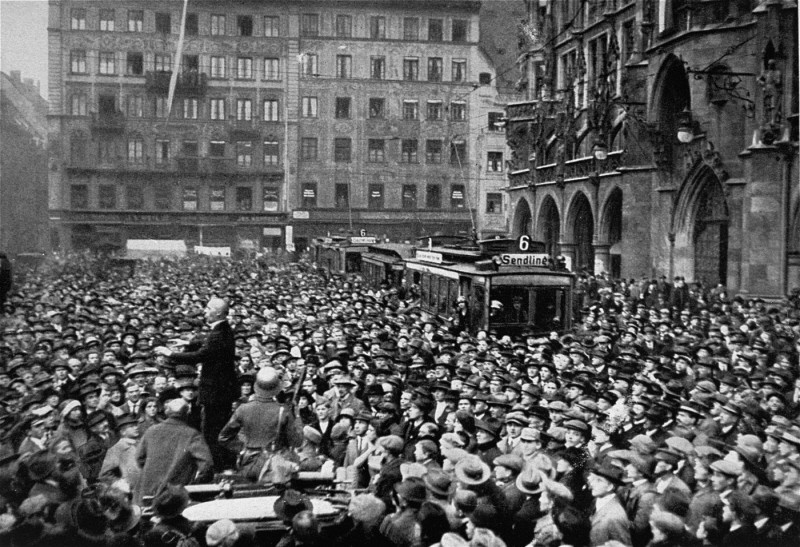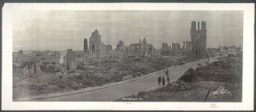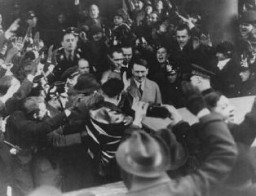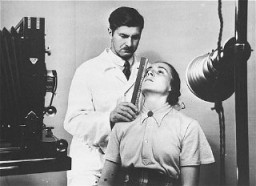
Beer Hall Putsch (Munich Putsch)
On November 8–9, 1923, Adolf Hitler and the Nazi Party led a coalition group in an attempt to overthrow the German government. The plotters hoped to march on Berlin to launch a national revolution. But the insurrection failed miserably. Units of the Munich police force clashed with Nazi stormtroopers as they marched into the city center. The police killed more than a dozen of Hitler’s supporters. This attempted coup d'état came to be known as the Beer Hall Putsch.
-
1
In 1923, the Nazi Party was a small, right-wing extremist group. In November of that year, they conspired to overthrow the democratic government of Germany by launching an ill-fated insurrection.
-
2
The Beer Hall Putsch was put down by authorities. Its ringleaders, including Adolf Hitler, were arrested. Hitler was convicted of high treason in April 1924 and sentenced to five years in prison. He was released in December that same year.
-
3
In the aftermath of the Beer Hall Putsch, Hitler decided on a "legal path" to revolution: the ballot box.
Background
On November 8–9, 1923, Adolf Hitler and the Nazi Party led a coalition group in an attempt to overthrow the German government. This attempted coup d'état came to be known as the Beer Hall Putsch.
They began at the Bürgerbräu Keller, a beer hall in the Bavarian city of Munich. Hitler and the Nazi Party aimed to seize control of the state government, march on Berlin, and overthrow the German federal government. They sought to establish a new government to oversee the creation of a unified Greater German Reich. In this new government, citizenship would be based on race.
The putsch failed and Bavarian authorities prosecuted nine participants, including Hitler. Despite its failure, the leaders ultimately redefined the putsch as a heroic effort to save the nation.
A Climate of National Instability
Throughout Germany, the first four years of the Weimar Republic were marred by economic woes, trauma at the loss of World War I, and humiliation at what many considered to be the excessively harsh terms of the Versailles Treaty. In this climate of national instability, both left and right wing political movements attempted and failed to overthrow the fledgling democracy.
By the time Hitler and the Nazis prepared their coup attempt in 1923, the movement counted more than 50,000 members. The majority of these members had joined with the hope that the party would take action against the democratic republic. Benito Mussolini’s successful “March on Rome”—which brought the Fascists to power in Italy in October 1922—inspired Hitler. He planned to seize control of the national government with a parallel “March on Berlin.”
At the same time, members of the Bavarian state government were agitating for change. The state government protested Berlin’s decision to halt passive resistance against Franco-Belgian troops occupying the Rhineland and the Ruhr. As a result, it declared a state of emergency. It put Minister President Gustav Ritter von Kahr in charge as a General State Commissar together with his associates Armed Forces General Otto von Lossow and State Police Chief Hans Ritter von Seisser.
This “triumvirate” of Bavarian leaders publicly advocated a nationalist march on Berlin. However, they secretly calculated that others in the military and civil service in Berlin would do the dirty work, sweeping away the hated Republic and establishing an authoritarian regime. The Bavarians could then enjoy the fruits of the putsch without taking its risks and also maintain their autonomy in Bavaria. However, as it became clear to the triumvirate that they had miscalculated, they contemplated taking action against Berlin on their own. They met on the evening of November 8, 1923, in the Bürgerbräu Keller to discuss strategy.
Meanwhile, the radical and völkisch nationalist coalition, including the Nazis, had united in a formation that they called the Kampfbund (Combat League). The völkisch leaders grew impatient. They pushed for a violent overthrow of the government in Berlin. Hitler, who had dubbed himself the “drummer” for the movements associated with the Kampfbund, feared Bavarian Minister-President Kahr more than any other leader as a potential rival.
Hitler and his fellow conspirators planned to crash the Bavarian leaders’ meeting on November 8. They intended to announce the Bavarian and federal government as deposed, forcing the triumvirate to legitimize Hitler’s movement. They planned to force Von Lossow and von Seisser to order Bavarian troops out on to the street in support of the government of “national renewal,” and, in conjunction with the paramilitary units in the Kampfbund coalition, to seize crucial administrative and military buildings. Once the coalition had secured Bavaria, its leaders would march on Berlin under Hitler's leadership.
The Putsch
At about 8:30 in the evening on November 8, Hitler's personal bodyguard detachment, the Stoßtrupp Adolf Hitler, arrived at the Bürgerbräu Keller to join the Storm Trooper units which were preparing to surround the beer hall. Hitler slipped inside the facility and took the arrival of the Stoßtrupp as the signal to begin the putsch. He fired his pistol into the ceiling, interrupting Kahr's rally, and declared that the “national revolution” had begun.
Surrounded by armed guards, Hitler pushed his way to the front and briefly addressed the crowd. He then ordered von Lossow, von Seisser, and von Kahr into an adjoining room. There, he bullied them at gunpoint into backing his putsch. Believing he had secured their support, Hitler and the three Bavarian leaders returned to the main hall and addressed the crowd. They declared their solidarity in Hitler's movement and announced the new government's key appointments.
Once they launched the putsch, however, the conspirators made a series of crucial mistakes. First, their overall success depended upon the seizure of state offices and communications centers. The conspirators also relied upon the use of the triumvirate's authority to bring in the military and police. While the rebels temporarily took over some offices, including the municipal headquarters of the Reichswehr and Munich police headquarters, they failed to secure other key centers.
Further, Hitler left the triumvirate in the custody of Erich Ludendorff, who yielded to their entreaties to leave the Bürgerbräu Keller, supposedly to take up their designated roles in the putsch. Once free, however, they denounced the overthrow. In addition, they ordered police and military units to suppress it. As the conspirators had failed to secure communications in the city, the triumvirate was able to call upon suburban police forces and troops from nearby bases.
The conspirators were too disorganized to take advantage of this short window of confusion. After he heard of the triumvirate's betrayal, Hitler equivocated for several hours before deciding to proceed with the march on Berlin. The indecision gave the Bavarian authorities time to organize and defend Munich.
In a last ditch effort to rally citizens and soldiers, Hitler led around 2,000 Nazis and other Kampfbund members in a march to the Feldherrnhalle on the Ludwigstrasse. Munich law enforcement clashed with the marchers as they reached the Odeonsplatz. The shootout left 14 Nazis and four police officers dead and put a final end to the coup in the city. Two other Nazis died in other localities. Hitler had relied on the paramilitary Kampfbund, but the lack of support from the police and locally stationed military units doomed the attempt.
Trial
A five-judge panel chaired by Georg Neithardt presided over the trial of Hitler and the other putsch leaders in March 1924.
Like the majority of judges during the Weimar period, Neithardt tended, in cases of high treason, to show leniency towards right-wing defendants who claimed to have acted out of sincere, patriotic motives. Wearing his Iron Cross, awarded for bravery during World War I, Hitler held forth against the Weimar Republic. He claimed the federal government in Berlin had betrayed Germany by signing the Versailles Treaty. He also justified his actions by suggesting that there was a clear and imminent communist threat to Germany.
The judges convicted Hitler on the charge of high treason. However, they gave him the lightest allowable sentence of five years in a minimum security prison at Landsberg am Lech with the possibility of parole. He was released in December 1924. While Hitler did have a base of support, left and right-wing newspapers criticized the leniency of his sentence. A prominent legal professor also published a paper outlining many of the trial's worst errors. Bavarian government officials were equally displeased. However, they acted with restraint to avoid giving the impression of trying to influence the affairs of the Bavarian Justice Ministry.
Hitler led a pleasant lifestyle for an inmate. Prison authorities allowed him to wear his civilian clothes, to meet with other inmates as he pleased, and to send and receive many letters. Prison authorities also permitted Hitler to use the services of his personal secretary, Rudolf Hess, a fellow inmate convicted of high treason. While in prison, Hitler dictated to Hess the first volume of his infamous autobiography, Mein Kampf.
The Legacy of the Beer Hall Putsch
The Beer Hall putsch had several ominous legacies.
Among those who marched with Hitler to the Odeonsplatz were men who would later hold key positions in Nazi Germany: Hermann Göring, Heinrich Himmler, Rudolf Hess, Julius Streicher, and Wilhelm Frick. After World War II ended in 1945, four of these men stood in the defendants’ dock at the trial of major war criminals in Nuremberg. The fifth only escaped that fate by committing suicide.
The aims of the putsch leaders were equally foreboding. For instance, they sought to smash internal political opposition and annihilate those who resisted. They planned to establish a dictatorial state and restrict citizenship to Germans of “Nordic” stock, as well as to exclude Jews from political life. In addition, they aimed to pass emergency legislation that would allow the “removal of all persons dangerous to security and useless eaters” who would be imprisoned “in concentration camps [Sammellager] and, where possible, turned to labor productive to the community.” When Hitler and the Nazis seized power in 1933, they achieved each of these goals within two years.
Hitler drew important practical lessons from the failed putsch. First, he understood that the Nazi movement could not destroy the Republic by direct assault without support from the Army and police. Second, he understood that success depended upon the Nazi Party as the undisputed leader of the völkisch movement and Hitler as the unequivocal leader of the Nazis. Finally, the experience taught Hitler that an attempt to overthrow the state by force would bring forth a military response in its defense.
From that time on, he was committed to taking advantage of the Weimar democracy to subvert the state from within. He sought to come to power by means of the popular vote. He aimed to influence that vote by using the freedoms of speech and assembly guaranteed by the Weimar Republic.
In the wake of the putsch, the federal and Bavarian government banned the Nazi Party, its formations, and its newspaper. But Hitler's public commitment to coming to power legally induced the authorities to lift the ban in 1925. Between 1925–1929, the party underwent a careful organizational restructuring under Hitler’s control. It would see its first significant result in the Nazi electoral breakthrough in the Reichstag elections of 1930.
Hitler and the Nazi Party leadership cultivated the memory of the putsch. They gave it a special place in the narrative of the Nazi movement, and eventually in that of the German state. After Hitler consolidated power, Nazi Germany celebrated November 9 as Reich Day of Mourning (Reichstrauertag).
The Odeonsplatz, the city square where the conspirators had clashed with police, became an important memorial for the Nazi Party. Only after World War II did authorities of the German Federal Republic dedicate a plaque memorializing the four police officers killed on duty in defense of the Weimar Republic.
Series: The Weimar Republic
Critical Thinking Questions
- If the overthrow of the government was unsuccessful, why was the Putsch a success for Hitler and the Nazi party?
- What pressures and motivations affected the decisions of political and military leaders on all sides during the Putsch crisis?
- 2023 marks the 100th anniversary of the Beer Hall Putsch. Why was this event significant? Why is it important to learn about this event?
- Consider the usual penalties for treason for attempted overthrow of a government. What is the penalty in your country? Why was Hitler’s sentence relatively light in comparison?
Further Reading
Gordon, Harold J., Jr. Hitler and the Beer Hall Putsch. Princeton, N.J.: Princeton University Press, 1972.
Kershaw, Ian. Hitler: 1889-1936: Hubris. New York: W.W. Norton and Company, 1998.
Pappert, Lars. Der Hitlerputsch und seine Mythologisierung im Dritten Reich. Neuried: Ars Una, 2001.
Willms, Johannes, ed. Der 9. November: Fünf Essays zur Deutschen Geschichte. Munich: Beck, 1994.











